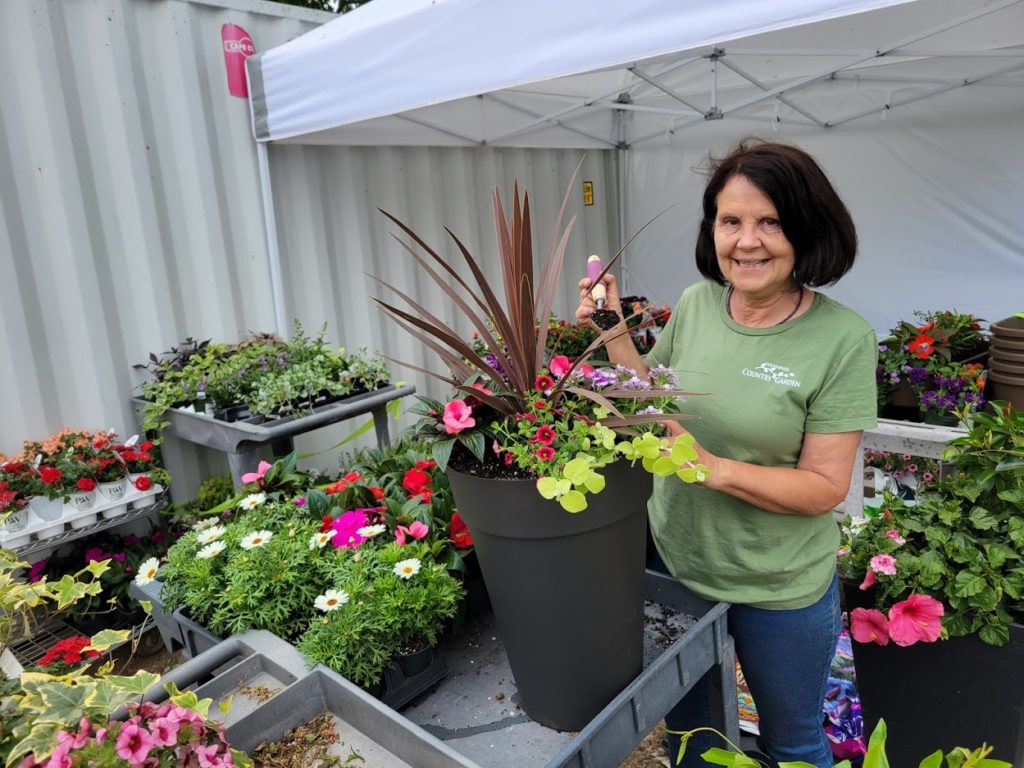Q & A From Last Week’s Happy Hour
Q & A From Last Week’s Happy Hour
Since we keep our virtual Horticultural Happy Hours to 60 minutes long, there are always a few questions typed in Chat that I haven’t gotten to. But I promise those on the call that I’ll answer them here, on the blog. So here are the questions that remained once the Container Combinations webinar ended.
Q. Can we start planting almost everything now? A. Although the long-range forecast looks good, there is one night this week that’s predicted to go to 41° or below. It’s likely that you’ll get away with planting summer things now, but since the nights are often still falling below 50°, you’re taking a chance that the plants may sulk or not do well. I personally am going to wait until next weekend (May 20th and 21st), and look at the ten day forecast then. If the night temperatures are predicted above 50° at that time I’ll feel confident in planting tomatoes, peppers, eggplants, and my summer annuals. In the meantime, I’m hardening my plants off by putting them outdoors in the day but remaining poised to bring them in later in the week if the nights are going to be cold.
Q. About how many plants do you typically put in a 20″ container for sun? A. It depends on what plants you’re choosing. One Senorita Rosalita Cleome would fill that entire pot, as would one tropical Hibiscus. But you could put one bidens, (Goldilocks Rocks), one Cupea Vermillionaire, and one spilling Mecardonia Gold Dust in that pot. You could even squeeze in one Persian Shield Strobilanthes with those three for some upright drama. The number of plants in a 20″ pot would also depend on how deep the pot is. If it’s only 12 or 16 inches deep, you would use one or two plants, but if the pot is 30″ deep you could use four to six, as long as you’re filling the entire container with potting mix.
Q. What are your thoughts on Osmocote Fertilizer with Plant-tone for containers? A. I’m fine with that combination. As I said in the program, the advantage of using a time-release synthetic along with a granular organic fertilizer is that the combination will get your annuals off to a fast start but the organic product will feed slowly and steadily later in the summer. So using both means that you wouldn’t have to fertilize again later in the summer. I personally like the Shake n’ Feed time release since it’s higher in nitrogen, and annuals are nitrogen-hogs. But if you like Osmocote, go with that by all means.
Q. Many of the pots you showed had gradual and great height…was that naturally done? A. That’s done by looking at the projected size of a plant that you’re not familiar with, and including some that grow taller (the classic “thriller”), some that are bushy (the “fillers”) and some that hang over the edge of a container (“spillers”). Some information about which plants grow tall and thin, and which ones get bushy is gained by experience, and finding out what a combination will do is part of the fun. Try some new plants every year, and take photos when you first plant them and then later in the summer. You’ll find some varieties that become your “must have” favorites, and others that you’ll be glad you tried but may not want to use again.
Here are some of my personal “must have” plants for pots.
Thrillers: King Tut and Queen Tut Papyrus. (Prince Tut is more of a filler and works best in a pot by himself I’ve found.) Persian Shield Strobilanthes (purple leaves – good in sun or shade); Tall Salvia varieties such as Black and Blue or the Rockin’ series from Proven Winners; In a large container, Senorita Rosalita or Blanca Cleome; Cordyline (purple or burgundy “spikes”); tropicals such as palms, crotons and cannas.
Filllers: Cuphea Vermillionaire (hummingbirds!); Bidens (any of them but Goldilocks Rocks is especially reliable); New Guinea Impatiens; Begonias (any but the non-stop tuberous types, which are more fussy about not staying wet around their stems, and can therefore rot out in mixed containers); Euphorbia Diamond Frost; Browallia Endless Illumination; Profusion Zinnias (we usually have these in six packs so they are also affordable); Mandevilla vines (short varieties aka Dipladenia); Scaevola.
Spillers: Scaevola (Yes! It’s a filler! It’s a spiller!); Superbena; Licorice plant; Dichondra Silver Falls; Snow Princess and Frosty Knight Lobularia; Mecardonia Gold Dust.
To name just a few… And by the way, the recording from the Container Combos Happy Hour will be at the bottom of our events page soon.
Enjoy!

2 Comments
Leave a Comment
Subscribe To Our Newsletter
Sign up for our weekly email about sales and events.

Hello. I would like a guide on choosing the right pelargoniums this year for a large old cranberry box.
HCG has so many choices and I don’t know the difference in varieties; Zonal vs regal vs ivy and other choices. I like deep rich colors that I can use with bluish companiions.
Thanks
DC
In a box you should use the regular Zonal geraniums – color of your choice. They are more upright while the ivy types drape over the edges. And speaking of draping, Scaevola makes a good blue flowering companion to geraniums, and you could plant that on the edge of the box. White Diamond Frost Euphorbia also plays well with the zonal plants.